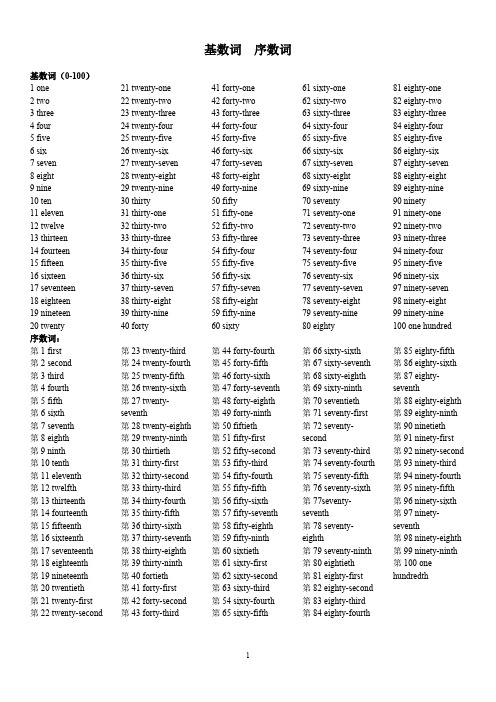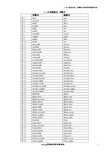4 数词
- 格式:doc
- 大小:46.50 KB
- 文档页数:6

四的序词英语序言在英语中,表示数字的序数词在表达顺序、排名、日期和年份等方面起着重要的作用。
其中,表示数字四的序数词也不例外。
本文将探讨表示数字四的序数词在英语中的用法和相关表达方式。
一、基本用法在英语中,表示数字四的序数词为"fourth"。
它用于表示位置、顺序和排名,通常用于修饰名词。
例句:1. He finished in fourth place in the race.(他在比赛中获得了第四名。
)2. This is the fourth time I've been to Paris.(这是我第四次来巴黎。
)3. She is the fourth child in her family.(她是家里的第四个孩子。
)二、衍生表达除了使用基本的序数词"fourth"外,英语中还有一些其他相关的表达方式来表示数字四的序数。
1. 基数词 + nth将基数词"four"与"th"结合,构成"fourth"之外的四的序数词。
这种表达方式可以用来表示较为正式和庄重的场合。
例句:1. We had a great time celebrating the fortieth anniversary of their wedding.(我们在庆祝他们婚礼的第四十个周年时度过了愉快的时光。
)2. The event will be held on Thursday, November fourteenth.(这个活动将于11月14日星期四举行。
)2. "the" + 基数词 + "of"在某些情况下,我们可以使用形如"the + 基数词 + of"的结构来表示数字四的序数。
这种表达方式通常用于表示顺序、排名和次序。
例句:1. She is the fourth of six children in her family.(她是家里六个孩子中的第四个。

基数词序数词基数词(0-100)1 one2 two3 three4 four5 five6 six7 seven8 eight9 nine10 ten11 eleven12 twelve13 thirteen14 fourteen15 fifteen16 sixteen17 seventeen18 eighteen19 nineteen20 twenty 21 twenty-one22 twenty-two23 twenty-three24 twenty-four25 twenty-five26 twenty-six27 twenty-seven28 twenty-eight29 twenty-nine30 thirty31 thirty-one32 thirty-two33 thirty-three34 thirty-four35 thirty-five36 thirty-six37 thirty-seven38 thirty-eight39 thirty-nine40 forty41 forty-one42 forty-two43 forty-three44 forty-four45 forty-five46 forty-six47 forty-seven48 forty-eight49 forty-nine50 fifty51 fifty-one52 fifty-two53 fifty-three54 fifty-four55 fifty-five56 fifty-six57 fifty-seven58 fifty-eight59 fifty-nine60 sixty61 sixty-one62 sixty-two63 sixty-three64 sixty-four65 sixty-five66 sixty-six67 sixty-seven68 sixty-eight69 sixty-nine70 seventy71 seventy-one72 seventy-two73 seventy-three74 seventy-four75 seventy-five76 seventy-six77 seventy-seven78 seventy-eight79 seventy-nine80 eighty81 eighty-one82 eighty-two83 eighty-three84 eighty-four85 eighty-five86 eighty-six87 eighty-seven88 eighty-eight89 eighty-nine90 ninety91 ninety-one92 ninety-two93 ninety-three94 ninety-four95 ninety-five96 ninety-six97 ninety-seven98 ninety-eight99 ninety-nine100 one hundred序数词:第1 first第2 second第3 third第4 fourth第5 fifth第6 sixth第7 seventh第8 eighth第9 ninth第10 tenth第11 eleventh第12 twelfth第13 thirteenth第14 fourteenth第15 fifteenth第16 sixteenth第17 seventeenth 第18 eighteenth第19 nineteenth第20 twentieth第21 twenty-first第22 twenty-second 第23 twenty-third第24 twenty-fourth第25 twenty-fifth第26 twenty-sixth第27 twenty-seventh第28 twenty-eighth第29 twenty-ninth第30 thirtieth第31 thirty-first第32 thirty-second第33 thirty-third第34 thirty-fourth第35 thirty-fifth第36 thirty-sixth第37 thirty-seventh第38 thirty-eighth第39 thirty-ninth第40 fortieth第41 forty-first第42 forty-second第43 forty-third第44 forty-fourth第45 forty-fifth第46 forty-sixth第47 forty-seventh第48 forty-eighth第49 forty-ninth第50 fiftieth第51 fifty-first第52 fifty-second第53 fifty-third第54 fifty-fourth第55 fifty-fifth第56 fifty-sixth第57 fifty-seventh第58 fifty-eighth第59 fifty-ninth第60 sixtieth第61 sixty-first第62 sixty-second第63 sixty-third第54 sixty-fourth第65 sixty-fifth第66 sixty-sixth第67 sixty-seventh第68 sixty-eighth第69 sixty-ninth第70 seventieth第71 seventy-first第72 seventy-second第73 seventy-third第74 seventy-fourth第75 seventy-fifth第76 seventy-sixth第77seventy-seventh第78 seventy-eighth第79 seventy-ninth第80 eightieth第81 eighty-first第82 eighty-second第83 eighty-third第84 eighty-fourth第85 eighty-fifth第86 eighty-sixth第87 eighty-seventh第88 eighty-eighth第89 eighty-ninth第90 ninetieth第91 ninety-first第92 ninety-second第93 ninety-third第94 ninety-fourth第95 ninety-fifth第96 ninety-sixth第97 ninety-seventh第98 ninety-eighth第99 ninety-ninth第100 onehundredth序数词下面把1-99的序数词分为四类:1、第一类first (1st) 第一second (2nd) 第二third (3rd) 第三(在括号里的是缩写形式,均在阿拉伯数字后面加上相应序数词的最后两个字母构成,以下各类与此相同。

核心词汇1. 动词: make制作show给……看2. 疑问代词: who谁,什么人3. 名词: bird鸟egg蛋baby幼崽;雏鸟4. 数词: one一two二three三four四five五six六seven 七eight八ten十eleven十一twelve十二5. 形容词: beautiful美丽的hungry饥饿的big大的little小的6. 副词: how多少;怎样,如何all全部,所有了解词汇1. 单词: count数数rope绳number数,数字cheep吱吱(或唧唧)的叫声amazing令人惊讶的only仅仅around环绕,在(……)周围everywhere在各个地方;处处2. 短语: Chinese knot中国结all around处处,到处核心句型1. Who can make a Chinese knot?谁能制作一个中国结?解读: who意为“谁”, can为情态动词,意为“能,会”,情态动词之后跟动词原形。
该句型直接用“人名”回答即可。
举一反三:—Who can play football?谁能踢足球?—My brother. 我的弟弟。
2. —What is it?它是什么?—This is a Chinese knot. 这是一个中国结。
解读: what意为“什么”, it意为“它”,表示单数形式,故be动词用is。
答语可以用“This is …”,也可以用“It’s…”。
举一反三:—What is it?它是什么?—It’s a ruler.它是一把尺子。
3. —How many ropes?有多少根绳子?—Only one rope!仅仅一根绳子!解读: how many表示“多少”,可以对某事物的数量进行提问,答语通常用“基数词+名词.”。
举一反三:—How many apples?有多少个苹果?—Two apples. 两个苹果。
4. That’s amazing!那很令人惊讶!解读: that意为“那,那个”, that’s=that is。

词汇汇总1. 数字Number基数词:one1 two2 three3 four4 five5 six6 seven7 eight8 nine9 ten10 eleven11 twelve12 thirteen13 fourteen14 fifteen15 sixteen16 seventeen17 eighteen18 nineteen19 twenty20 thirty30 forty40 fifty50 sixty 60 seventy 70 eighty 80 ninety90 hundred 百thousand 千million百万序数词:first第一second第二third第三fourth第四fifth第五sixth第六seventh第七eighth第八ninth第九tenth第十eleventh第十一twelfth 第十二2. 食物foodmeat肉noodles面条bread面包rice米饭sweets 糖果peanut 花生biscuit 饼干soup汤cake蛋糕milk牛奶fish鱼肉ice-cream冰激凌fast food快餐chocolate巧克力cheese奶酪egg 鸡蛋hot dog 热狗sausages香肠tea 茶chips薯条moon cake月饼hamburger 汉堡cola可乐beef 牛肉water 水tofu 豆腐chicken 鸡肉pork 猪肉vegetable蔬菜tea 茶coffee 咖啡juice果汁(breakfast 早餐lunch 午餐dinner 晚餐)3. 水果fruitapple苹果pear梨子mango芒果banana香蕉orange橙子watermelon 西瓜4. 时间Timemorning早上afternoon下午evening晚上tonight今晚year年tomorrow明天minute分钟today今天yesterday昨天weekend周末o’clock时钟night 晚上break课间休息sometimes 有时holiday 假日someday有一天week星期Monday星期一Tuesday星期二Wednesday星期三Thursday星期四Friday 星期五Saturday星期六Sunday星期日month月份January一月February二月March 三月April四月May五月June六月July七月August八月September九月October十月November十一月December十二月hour 小时5. 节日FestivalNew Year新年Christmas圣诞节Spring Festival春节Children’s Day儿童节Thanksgiving感恩节Dragon Boat Festival 端午节Flag Day国旗日Lantern festival元宵节Mid-Autumn festival 中秋节6. 学校schoolbag书包book书paper纸pen钢笔pencil铅笔ruler尺子chair椅子desk 书桌homework作业pencil-box铅笔盒word单词dictionary字典library card图书卡Classroom教室card 卡片,贺卡letter字母middle school中学Chinese语文Math三数学Science科技课Music音乐课English英语physics 物理chemistry化学geography 地理7. 运动类sportball球basketball篮球skipping-rope跳绳football足球table-tennis乒乓球high jump跳高swimming游泳cycling骑自行车long jump跳远morning exercises早操race比赛baseball棒球Olympic Games 奥林匹克8. 动物animalbird鸟fish鱼panda大熊猫snake蛇cat猫lion狮子dog狗parrot鹦鹉dragon龙tiger老虎monkey猴子elephant大象chicken 鸡chick小鸡owl猫头鹰duck鸭子pet 宠物pig猪cow 牛sheep羊horse马frog青蛙rabbit兔子mouse老鼠kangaroo袋鼠monkey 猴子panda熊猫snake蛇9. 颜色colourblue蓝色red红色yellow黄色black黑色white白色brown褐色orange橙色green 绿色10. 交通工具:car汽车plane飞机bus公共汽车boat小船ship轮船train火车bike自行车bicycle自行车van 邮车lorry卡车spaceship 宇宙飞船11. 肢体部位Bodyear耳朵hand手arm手臂eye眼睛head头foot足mouth嘴巴leg腿nose 鼻子hair头发shoulder肩膀12. 服饰clothesshirt,衬衣shorts短裤skirt短裙jacket夹克trousers裤子sock袜子cap鸭舌帽hat有沿帽swimsuit泳衣coat外套dress连衣裙T-shirt T恤衫sweater 毛衣pocket口袋shoe鞋13. 国家countryChina中国Chinese中国的England英国English英国的India印度Indian印度的American美国的America美国Scotland苏格兰Australia 澳大利亚UN联合国14. 家庭FamilyDad爸爸father父亲parent父母brother兄弟mum妈妈mother母亲grandpa祖父grandma祖母cousin堂兄弟sister姐妹grandparent祖父母son 儿子15. 称呼:friend朋友children孩子们child 孩子(单数)boy男孩girl女孩queen 女王kin亲戚men 男人(复数) women 女人(复数) pen friend 笔友16. 职业teacher老师doctor医生driver司机nurse护士farmer农民pupil小学生worker 工人clown小丑goalkeeper守门员fireman消防员acrobat杂技演员painter 画家postman邮递员policeman警察model模范17. 音乐类music音乐erhu二胡guitar吉他drum 鼓zither古筝pop music流行音乐song歌曲Classical music古典音乐flute笛trumpet喇叭violin 小提琴dancing 舞蹈trumpet 小号18. 家居类room房间bedroom卧室bathroom 浴室living room 客厅kitchen 厨房dining room 餐厅window窗户hammer锤子floor 地板light灯chopsticks筷子house房屋shelf架子oil lamp油灯newspaper 报纸sofa 沙发vase 花瓶bed床ticket 票toothbrush牙刷fork 叉子knife餐刀stamp邮票cup茶杯door门photo 相片picture图片cooker炊具box盒子doorbell 门铃19. 电器:computer电脑radio收音机telephone电话TV电视camera相机screen屏幕CD激光唱盘CD-Rom 只读光盘television电视electricity电phone 电话电脑Computer: keyboard 键盘monitor显示器laser printer激光打印机mouse鼠标video 录像带icon图标address地址information信息message 信息E-card电子贺卡E-mail 电子邮件20. 大自然类sea海river河流island 岛stone 石头mountain 大山hill小山water水lake湖tree 树flower花sky 天空cloud云sun 太阳bamboo竹子fire火world 世界21. 娱乐Barbie doll芭比娃娃teddy bear玩具熊jigsaw拼图游戏kite风筝slide 滑梯swing秋千chess 国际象棋game游戏magazine杂志pet宠物balloon 气球24. 地点:station 车站school 学校park 公园department store百货商店pond 池塘playground 游乐场community社区circus马戏团factory 工厂library图书馆prairie草原theatre戏院airport飞机场building大楼Chinatown唐人街restaurant饭馆square广场farm农场space 太空25. 景点:Buckingham Place白金汉宫Hyde Park海德公园the London Eye伦敦眼River Thames泰晤士河Tower Bridge塔桥Big Ben大本钟Mount the Yellow River黄河the Changjiang River长江the Great Wall长城Mount Tai泰山West lake 西湖the Summer Palace颐和园Science Museum 科学博物馆Ming Tombs明陵26.城市CityWashington D.C.华盛顿New York纽约San Francisco旧金山Canada加拿大Sydney悉尼Hong Kong香港Shanghai上海Beijing北京Fujian福建Xiamen厦门Tibet西藏Harbin哈尔滨27.天气Weatherwarm温暖hot热的cool凉爽的cold寒冷的rainy下雨的sunny阳光充足的windy刮风的snowy下雪wet湿的season,季节spring春summer 夏autumn (fall) 秋winter 冬28. 疼痛:headache头痛stomachache胃痛cold感冒fever发烧29. 感觉Feeling:sad悲伤的hungry恶的thirsty渴的tired累的shy害羞的exciting兴奋的happy高兴的angry 生气的bored无聊的excited兴奋的nervous紧张的normal 正常的pleased高兴的30. 形态fat胖的thin瘦的tall高的short矮的long长的small小的big大的old老的young年轻的little年幼的strong强壮的large 大的light轻的31. 方位词at在…方面in在…里面on在…上面next to相邻under在…下面down向下over在…上up向上near附近left左边right右边north北west西around在…周围east东south南inside在…内32.人称he他I我it它my我的she她they他们we我们you你(你们) your你(你们)的them他们(宾格)me我us我们myself我自己their他们的mine我的yours 你(你们)的hers她的his他的herself她自己33. 指示代词:this这个that那个these这些those那些here这里there那里all over 到处34. 疑问词how怎么what什么where哪里why为什么how much 多少whose谁的which 哪个35. 副词:now现在about关于any一些bit一点every每一个for为了by乘all所有的from来自just仅仅so所以some一些then然后very非常with和---一起everything任何事than比… one某物also也need要but但是very 很too也well很好地badly很糟的together一起slowly 慢地still仍然abroad国外another另一个quickly 迅速地already已经never从不soon不久more更多maybe可能again再一次always总是hurry 赶紧often常常such这样的(地) because因为loudly 大声地everyone每个人36.词组:come on 快点lots of 许多over there 在那边Sports day运动日turn on 开灯stand up 起立point to指向sit down 坐下one day一天have breakfast吃早饭have lunch吃午饭have dinner吃晚饭watch TV看电视go to work 上班go home回家half past ……点半the others其它Spring Festival春节Christmas 圣诞节New Yea新年take pictures照play with 和……玩go straight on直着走Excuse me对不起next to 与……邻接go to school上学of course当然 a lot 很多good at 擅长at all根本by himself 靠他自己be made of 是……制成的go out 出去tide up 整理in a hurry 匆忙used to过去常常 a litter日少量look for 寻找for now 暂时have to必须switch on 打开think of思考the same as和……一样letter box 邮箱all around 到处in line成一条直线out of 往外。

数词的意义及用法是什么数词的意义及用法是什么数词表示数量或顺序的词叫做数词。
的数词可以作句子的主语、宾语、表语和定语。
下面是店铺给大家整理的数词的意义简介,希望能帮到大家!数词的意义英语上数词分为两大类:基数词和序数词意义:序数词是指表示顺序的数词。
序数词其主要形式:(1)从第一至第十二:one—first two—second three—third four-fourthfive— fifth six— sixth seven— seventh eight—eighth nine—ninthten— tenth eleven— eleventh twelve— twelfth大多的序数词都是由其相对应的基数词后面添加“th”构成。
(2)从第二十至第九十九整数第几十的形式由其对应的基数词改变结尾字母y为ie,再加“th”构成。
twenty——twentieth thirty——thirtieth表示第几十几时,用几十的基数词形式加上连字符“-”和个位序数词形式一起表示。
thirty-first 第三十一fifty-sixth 第五十六seventy-third 第七十三 ninety-ninth 第九十九第一百以上的多位序数词由基数词的形式变结尾部分为序数词形式来表示。
one hundred and twenty-first 第一百二十一 one thousand,three hundred and twentieth 第一千三百二十序数词的缩写序数词的缩写形式有时,序数词可以用缩写形式来表示。
主要缩写形式有。
first—lst second—2nd third—3rd fourth—4th sixth—6thtwentieth—20thtwenty-third——23rd 其中lst,2nd,3rd为特殊形式,其它的都是阿拉伯数字后加上th。
序数词的句法功能序数词在句中可作主语、宾语、定语和表语。

1—100的基数词、序数词英语中数词主要分为:基数词和序数词两类。
基数词:表示数目的词。
2,648 two thousand six hundred and forty-eight16,250,064 sixteen million two hundred and fifty thousand sixty-four5,237,166,234 five billion,two hundred and thirty-seven million,one hundred and sixty-sixthousand,two hundred and thirty-four1.基数词在表示确切的数字时,不能使用百、千、百万、十亿的复数形式;当基数词表示不确切数字,如成百、成千上万,三三两两时,基数词以复数形式出现。
There were hundreds of people there.有数百人在那里。
By the time you read this, the Hubble’s eagle eye will have sent us thousands and thousands of wonderful pictures.等到你读到这篇文章时,敏锐的哈勃望远镜已为为我们送来了成千上万张精彩的照片。
2. 有时两个复数形式的基数词连用可写为: hundreds of thousands of , tens of hundreds of 等。
They went to the theatre in twos and threes.他们三三两两地来到了剧院。
3. 表示人的不确切岁数或年代,用几十的复数形式表示。
He became a professor in his thirties.他三十多岁时成为了教授。
She died of lung cancer in forties.她四十来岁时死于肺癌。
In his twenties, Frank used to make spare parts for aeroplanes. 20多岁的时候,弗兰克曾生产飞机零部件。
数词(numeral)表示数目多少或顺序先后的词叫做数词(numeral)。
数词与不定代词很相似,其用法相当于名词与形容词. 数词有两种。
表示数目多少的数词叫做基数词(cardinal numberal),如one, ten, fifty—two等。
表示顺序先后的数词叫做序数词(ordinal numeral),如first,tenth,fiftieth等。
(一)基数词1)1—12的基数词是:one 1 seven 7 two 2 eight 8 three 3 nine 9 four 4 ten 10 five 5 eleven 11 six 6 twelve 1213-19,皆由3—9加后缀—teen构成,即:thirteen 13 seventeen 17 fourteen 14 eighteen 18 fifteen 15 nineteen 19 sixteen 16 (注意:thirteen,fifteen,eighteen的拼法)20—90等十位数均由2—9加后缀—ty构成,即:twenty 20 thirty 30 forty 40 seventy 70 fifty 50 eighty 80 sixty 60 ninety 90 (注意:twenty, thirty, forty, fifty, eighty的拼法)21—29由十位数20加个位数1—9构成,中间须有连字符“-”,即:twenty—one 21 twenty-six 26 twenty—two 22 twenty-seven 27 twenty—three 23 twenty—eight 28twenty—four 24 twenty-nine 29 twenty—five 25其它的十位数照此类推,如: thirty-one 31 seventy—five 752)百位数由1—9加hundred构成,如包含十位数及个位数,中间用and连接,也可以不用;如只包含个位数,即十位数为零时,则and不可省.如:a (one) hundred 100 two hundred 200 seven hundred and six 706a (one)hundred (and)twenty—five 125 three hundred (and)forty—one 341 nine hundred (and)eighty—seven 987 twelve hundred 1200 (英语中从1 100—1 900之间的整数常用hundred表示)3)千位数由1-9加thousand构成,其后的百、十、个位数构成方法同前。
专题一数词一.概述表示―多少‖或―第几‖的词叫做数词。
数词分为基数词和序数词。
基数词:表示―多少‖的词。
如:one ,two ,three序数词:表示―第几‖的词。
如:first ,second ,third单词复习:数词(numbers):one一two二three三four四five五six六seven七eight八nine九ten十eleven十一twelve十二thirteen十三fourteen十四fifteen十五sixteen十六seventeen十七eighteen十八nineteen十九twenty二十thirty三十forty四十fifty五十sixty六十seventy七十eighty八十ninety九十forty-two四十二hundred百one/a hundred and thirty-six一百三十六first第一second第二third第三fourth第四fifth第五eighth第八ninth第九twelfth第十二twentieth第二十thirtieth第三十fortieth第四十fiftieth第五十sixtieth第六十seventieth第七十eightieth第八十ninetieth第九十fifty-sixth第五十六句型复习:单纯数字运用(基数词与序数词)1. A: How old are you? 你几岁啦?B: I’m nine. / I’m 12 years old. 我九岁了。
2. Our lucky number is 6.3. —What size? —Size five.4. A: How do you do that? B: First, dig holes. Second, put the trees. .A: What should you do then? B: Water it.谈论价格1.A: How much is it? B: It’s ten yuan.A: How much are they? B: They’re three yuan.2. A: How much is that /this colourful dress? B: Very expensive. It’s ninety-nine yuan.A: How much are your jeans? They’re 30 yuan.问数量:1. A: How many balloons\ gifts? 多少个气球\礼物?B: Four \ ten. 四/十。
高中英语语法模块之数词数词分两类:基数词和序数词I.基数词:表示数目的词为基数词。
其表达式:1.21-99的两位数,在十位数和个位数之间加连字符构成。
如:fifty- three (53)2.101-999的三位数由hundred加and再加两位数或末位数。
three hundred and twenty-five (325)3.基数词hundred,thousand,million,billion表示确切数目时不能加sfive thousand students (五千个学生)但在表示不确切数目时,要用复数形式,如:hundreds of/thousands of students(许多学生)4.dozen和score的复数形式应注意以下几点:①dozen表示:一打,十二个,score表示:二十;②当dozen与数词,或many,several等连用时,不加“s”,所修饰的名词前常省去“of’;score则不然。
two dozen pencils两打铅笔two score of pencils四十支铅笔dozens of people=scores of people许多人③当后面的名词前有"these",“those",“them"," us"等词时, dozen后应加"of "。
a dozen of these peopletwo dozen of themthree score and ten people中不加of(七十人)II.序数词:表示顺序的数词为序数词。
其表达式:1.序数词一般由基数词后+th构成,前面一般加定冠词the,表示“第几”the two hundredth,the eighteenth加不定冠词,则意为“又一,再一”.I like the film very much, so I want to see it a second time.2.以ty结尾的基数词构成序数词时,先把y改成i,再加eth。
如:the twentieth,the fiftieth3.不规则的序数词有以下几个:first,second,third,fifth,eighth,ninth,twelfth4.“二十”以上的多位数,个位数用序数词,其余仍用基数词。
ninety-third one hundred and forty-ninth5.基数词与序数词连用时,通常是序数词在前the first two pages of the book(这本书的前两页)III.分数、小数和百分数的表达1.分数由基数词和序数词合成,分子用基数词,分母用序数词,分子大于1时,分母的序数词要用复数形式1/3:one(a)third 2/3:two thirds three-sevenths:七分之三特殊的表达①1/2:one(a)half 1/4:one(a)quarter/one(a)fourth 3/4:three quarters②分子与分母之间加in或out of,分子在前,分母在后,分子分母都用基数词one in ten:十分之一five in eight:八分之五one out of ten:十分之一five out of eight:八分之五2.百分数的表示法表示百分数直接将数词放在单词percent前面即可:twenty percent=20%百分之二十。
注意:分数和百分数后面不能直接接名词或代词,而用以下形式:分数/百分数+of +冠词/限定词+名词/代词,其谓语动词与of后的名词在人称和数上保持一致Two-thirds of the money was spent on food.About seventy percent of the earth surface is covered by water.3.小数的表示法小数的表示法,小数点前的总值发同其他数词一样,小数点用point,小数点后面的数读成个位数9.65表示为nine point six five。
218.39表示为two hundred and eighteen point three nine。
注意:小数点读point,“零”读字母o的音或zero,小数点前就按基数词去读,小数点后的数字按个位基数词依次读出。
62.62读作sixty-two point six twoIV.数词的其它表达式1.序号的表示法①单纯的序号,可在基数词前加number,简写为No.。
No.1第一号②事物名词的序号表达法有什所不同:对于一些小序号可有序数词也可用基数词表达,形式分别为:the +序数词+ 名词;名词+ 基数词第一次世界大战可以表示为the First World War或World War I。
对于一些大序号我们通常只用一种表达法,即名词+ 数词501号房间表示为Room 501538路公共汽车表示为Bus 538可用a/the + number + 基数词+ 名词a No.5 bus一辆五路公共汽车the No.8 bus那辆8路公共汽车2.倍数的表达方式一般情况下我们用以下三种倍数表达方式:①倍数用在as+形容词/副词(原级)+名词+ as结构之前They have three times as many cows as we do.他们拥有的奶牛是我们的三倍多。
②倍数放在形容词或副词的比较级之前或by + 倍数用在比较级之后This rope is four times longer than that one.They produced more products in 2009 than those in 2008 by twice.2009年的产品是2008年的两倍③倍数用在表示度量名词前,其基本结构为:倍数+ the + size / length / weight …+ of + 表示比较对象的名词,也可用于倍数+ what引导的从句中This room is three times the size of that one.The college is twice what it was 5 years ago.这个学院是5年前的两倍。
You can’t imagine that rats eat 40 to 50 times their weight.3.大约数的表示法①用ten、dozen、score、hundred、thousand、million等数词的复数后加of短语来表示几十、几百、上千、成千上万等大约数概念The little boy buys dozens of pencils every term.数打铅笔Thousands of people died in the earthquake.数千人Every year tens of thousands of people go to work in Guangdong Province.②用less than、under、below、almost、nearly、up to等来表示小于或接近某数目He is good at English, so he can finish the paper in less than two hours.不到两个小时③用more than、over、above、beyond、or more等来表示超过或多于某个数目Peking University has a history of more than 100 years.有100多年的历史④用or、or so、about、around、some、more or less等表示在某一数目左右About 50 people were present at that time.⑤用to、from … to…、between … and表示介于两数词His salary rises from 20 dollars a week to 35 dollars a week.从每周20美元涨到每周35美元注意:dozen、score、hundred、thousand、million作数词表示确切数量时,不用复数three score, five dozen, seven million等。
4.钟点、日期、年龄的表达式①钟点正读法10:20:ten twenty倒读法9:30:half past nine(九点半)7:05:five past seven(七点过五分)8:50:ten to nine (八点五十;差十分是九点)表示整点8:00:eight o'clock (sharp)表示在某个钟点,用介词atThey begin to work at half past seven.(他们七点半开始工作。
)②日期年代用基数词,在某年要用介词in:He was born in l983.他出生于1983年。
月份首字母要大写,在某月也用介词in,如果有年代出现,在月份名后加年代,中间用逗号:It happened in January,2009.这事发生在2009年1月。
月日同时出现时可有两种表示法:英国说法:顺序为先日后月:4(th)May(五月四日——读成:the fourth of May)美国说法:顺序为先月后日:May 4(th)(五月四日——读成:May the fourth)表示在某月某日,不管用在前还是在后,都用介词on:The meeting will be held on March 9(th).We'll leave for Shanghai on 8th June.年月日同时出现时,年代位于最后,其前加逗号:Mary was born on January 1st,1990.表示“在几十年代”用in十the十逢十的数词复数:in the 1990s/1990’s③年龄用基数词表示年龄。
如:The baby is one year old.表示“在某人的几十岁”时,可用介词in+ one’s+整十位数的复数形式:She is still in her twenties.她才二十几岁。
但表示十多岁时用:in one’s teens表示“一个九岁的男孩”,可以有多种表达法a boy of nine,a boy of nine years old,a boy of nine years of age,a nine-year-old boy注意:与基数词合成的定语,其中的名词用单数:a three-month-old baby,a five-year plan。